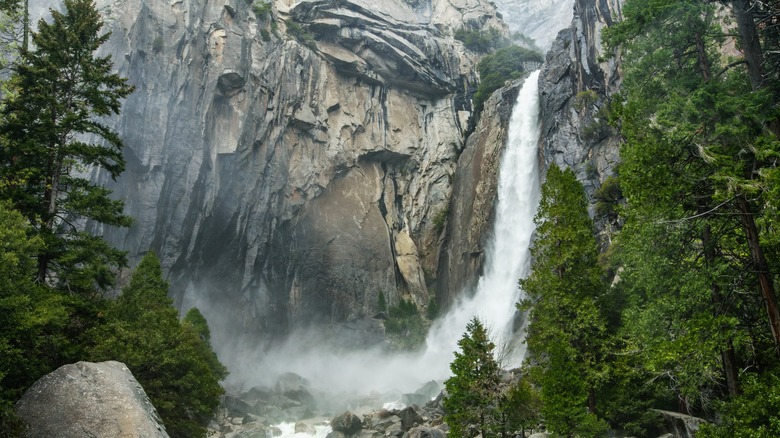A visit to Yosemite National Park is always a spectacular time. You may see wildlife like bears or buffalo (that you should absolutely not take a selfie with). You can stay at Old Faithful Inn, one of the world’s largest iconic log structures, and step out the door to see the legendary geyser of the same name. You can take tours, learn about the area, and wander down over 750 miles of hiking trails. One of those hikes is not only popular with gorgeous views, but part of it is wheelchair and stroller accessible. This hike is the Lower Yosemite Fall Trail. (Yes, that’s “fall” singular.) It’s the bottom portion of the 2,425-foot Yosemite Falls, though you can see the entire thing from one side of the trail.
There are several ways to get to the hike, including a shuttle to the trailhead, and some fantastic places to take the perfect picture or video for social media. There are, however, a few things you need to know before you go. Here’s all the information on the Lower Yosemite Fall Trail, current information about reservations, parking, and what you need to wear.
The Lower Yosemite Fall hike

The entire Yosemite Falls (upper and lower) is the tallest waterfall in North America, and the lower part is the final 320-foot drop. This area is pretty loud, with rushing water in the spring and early summer when the fall is at its peak. You may find it dry or at least less intense from late July and August through October. If you’re visiting when the fall is roaring, you’re likely to get splashed or misted as you get close to the water, particularly on the footbridge (seen above) as you get close, so make sure to wear something water resistant if you mind that.
There’s no parking at the trailhead, but you can park at Yosemite Village or Yosemite Falls parking areas, then take the Valleywide Visitor Shuttle to stop #6 from 7 a.m. through 10 p.m. You can also walk from the Visitor Center, which is about a half mile. When you get to the trailhead, you can go in either direction, though it’s recommended to walk clockwise if you want to get the best views of both the upper and lower falls. The eastern side of the path is accessible for wheelchairs and strollers unless there is ice or snow in the winter. The entire loop is a mile long and only has an elevation gain of 50 feet, which makes it great for even little kids, who will marvel at the mist-clouded area, the rocks, and the pine forest.
What you need to know about the Lower Yosemite Fall Trail

Lower Yosemite Fall Trail is one of the national park’s most popular trails, along with the Mist Trail that takes you to Vernal Falls’ beautiful waterfall views, so you’re likely to have a lot of people with you. It’s likely to take you around 30 minutes, though that depends on how long you decide to pose for pictures. Make sure to stay on the paved trail, as the rocks can be slippery, even when they’re not wet. Since this is a family-friendly hike, bathroom locations are important. There is one on the western side, along with water fountains. There are also exhibits around where you can get information about the area.
If you’re paying Yosemite National Park a visit, you’ll need a reservation to drive into and through the park from April 13 through October 27, 2024, between the hours of 5 a.m. and 4 p.m. — but only on some days. They’re $2 per person in addition to the $35 fee per vehicle. You don’t need the reservation if you already have one for a campground, a Half Dome permit, or in-park lodging and hotels. Check out the National Park Service website for specific dates around when you’ll need a reservation and more details. If you’re just passing through for one day, here are some must-do activities in Yosemite National Park.

